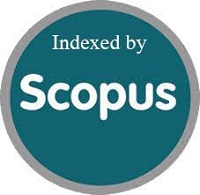Construct Validity of Unidimensional General Self-Efficacy Using Confirmatory Factor Analysis
DOI:
https://doi.org/10.15408/jp3i.v10i1.17150Keywords:
general self-efficacy scale, construct validity, confirmatory factor analysisAbstract
Self-efficacy is a specific domain which is divided into several aspects (e.g., magnitude, strength, and generality) based on Bandura’s theory. However, many researchers attempt to generalize the concept of self-efficacy to examine personal competence in a broader view. This study aims to test the validity of items on the General Self-Efficacy Scale (GSES), a measuring instrument that was developed by Ralf Schwarzer and designed by Matthias Jerusalem in 1979 to regulate the construction of self-efficacy as a broader concept of personality. This research used the Confirmatory Factor Analysis (CFA) method on 643 students in the Jabodetabek area to test the instrument’s validity and the CFA test results showed that out of the 10 items tested, the written statement is valid to measure the General Self-Efficacy variable.References
Bandura, A. (1997). Self-efficacy: the exercise of control. New York: W. H. Freeman and Company.
Breso, E., Schaufeli, W. B., & Salanova, M. (2011). Can a self-efficacy-based intervention decrease burnout, increase engagement, and enhance performance? A quasi-experimental study. High Education, 61, 339-355.
Brown, T. A. (2006). Confirmatory factor analysis for applied research. New York: The Guilford Press.
Byrne, B. M. (2012). Structural equation modeling with Mplus basic concept, applications, and programming. New York : Taylor & Francis Group.
Chau, H., & Hocevar, D. (1995). The effect of number of measured variables on goodfness-of fit in confirmatory factor analysis. Report – Evaluatif/Feasibility, 142.
Chen, G., Gully, S., & Eden, D. (2001). Validation of a new general self-efficacy scale. Organizational Research Methods, 4(1), 62-83.
Demiroren, M., Turan, S., & Oztuna, D. (2016). Medical student’s self-efficacy in problem-based learning and its relationship with self-regulated learning. Medical Education Online, 21.
Gaskill, P. J., & Hoy, A. W. (2002). Self-efficacy and self-regulated learning: the dynamic duo in school performance. Improving academic achievement, 9, 185-207.
Hoyle, R.H. (2004). Confirmatory factor analysis. In M. Lewis-Back, A. Bryman, & T. Liao (Eds.). Encyclopedia of social science research methods, 1, 169-175.
Hu, L & Bentler, P. M. (1999). Cutoff criteria for fit indexes in covariance structure analysis: Conventional criteria versus new alternatives. Structural Equation Modeling: A Multidisciplinary Journal, 6 (1), 1-55.
Hu, L., & Bentler, P. M. (1998). Fit indices in covariance structure modeling: sensitivity to under parameterized model misspecification. Psychological Methods, 3(4), 424-453.
Juárez, F., & Contreras, F. (2008). Psychometric properties of the general self-efficacy scale in a Colombian sample. International Journal of Psychological Research, 1(2), 6-12.
Linnenbrink, E. A., & Pintrich, P. R. (2002). Motivation as an enabler for academic success. Psychology Review, 31.
Luszczynska, A., Don˜a, B.G., & Schwarzer, R. (2005). General self-efficacy in various domains of human functioning: Evidence from five countries. International Journal of Psychology, 40 (2), 80–89.
Luszczynska, A., Scholz, U., & Schwarzer, R. (2005). The general self-efficacy scale: multicultural validation studies. The Journal og Psychology, 139(5), 439-457.
Muthén, L.K. and Muthén, B.O. (1998-2012). Mplus user’s guide. Seventh edition. Los Angeles, CA: Muthén & Muthén.
Pajares, F. (1996). Self-efficacy beliefs in achievement settings. Review of Educational Research, 66, 543–578.
Prudon, P. (2015). Confirmatory factor analysis as a tool in research using questionnaires a critique. Comprehensive Psychology, 4(10), 1-18.
Scherbaum, C.A., Charash, Y.C., & Kern, M.J. (2006). Measuring general self-efficacy: a comparison pf three measures using item response theory. Educational and psychological measurement, 66(6), 1047-1063.
Scholz, U., Doña, B.G., Sud, S. & Schwarzer, R. (2002). Is general self-efficacy a universal construct? psychometric findings from 25 countries. European Journal of Psychological Assessment, 18(3), 242-251.
Schunk, D. H., & DiBenedetto, M. K. (2015). Self-efficacy: education aspects. International Encyclopedia of the Social & Behavioral Sciences, (2nd) 21, 515-521.
Schunk, D. H., & Pajares, F. (2009). Self-efficacy theory. In K. R. Wentzel & A. Wigfield (Eds.), Handbook of motivation at school. New York : Routledge.
Schwarzer, R., Babler, J., Kwiatek, P., Schroder, K., & Zhang, J.X. (1997). The assessment of optimistic self-beliefs: comparison of the german, spanish, and chinese versions of the general self-efficacy scale. Applied Psychology: An International Review, 46(1), 69-88.
Schwarzer, R., Born, A., Iwawaki, S., Lee, Y.-M. (1997). The assessment of optimistic self-beliefs: Comparison of the Chinese, Indonesian, Japanese, and Korean versions of the General Self-Efficacy scale. Psychologia: An International Journal of Psychology in the Orient, 40(1), 1–13.
Schwarzer, R., & Jerusalem, M. (1995). Generalized self-efficacy scale. In J. Weinman, S. Wright, & M. Johnston (Eds.), Measures in health psychology: A user’s portfolio. Causal and control beliefs, 35–37.
Stubbs, N. S., & Maynard, D. M. B. (2017). Academic self-efficacy, school engagement and family functioning, among postsecondary students in the Caribbean. Journal Child Family Studies. 26, 792-799.
Zhang, B., Yan, X., Zhao, F., & Yuan, F. (2015). The relationship between perceived stress and adolescent depression: the roles of social support and gender. Social Indic Res, 123, 501-518.
Zimmerman, B. J. (1995). Self-efficacy in changing societies. New York : Cambridge University Press.



